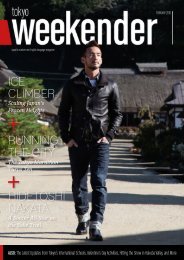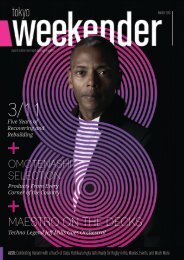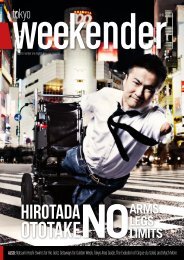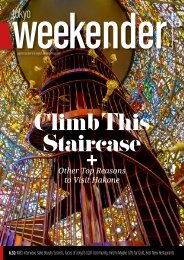Tokyo Weekender July 2016
Breaking the rules of kimono – a new book shatters antiquated views of this traditional garment. Plus: The boys for sale in Shinjuku Ni-chome, best sake of 2017, Japan's new emperor, and what really goes on inside "Terrace House."
Breaking the rules of kimono – a new book shatters antiquated views of this traditional garment. Plus: The boys for sale in Shinjuku Ni-chome, best sake of 2017, Japan's new emperor, and what really goes on inside "Terrace House."
You also want an ePaper? Increase the reach of your titles
YUMPU automatically turns print PDFs into web optimized ePapers that Google loves.
ody surfing on snowy banks, and playing<br />
with balls.<br />
It was probably a combination of these<br />
traits, as well as their sheer number, that<br />
drew a filmmaking couple, Kris Samuelson<br />
and John Haptas, to devote a few years to the<br />
crows of <strong>Tokyo</strong>. They got their first exposure<br />
to the birds when they were returning from<br />
teaching in Southeast Asia and stopped for a<br />
while in <strong>Tokyo</strong>. As they explained, “there was<br />
a garden where we were staying and we were<br />
amazed by the huge number of crows we<br />
heard and saw. We were intrigued and began<br />
noticing them everywhere we went.”<br />
Samuelson and Haptas returned home<br />
to Northern California, intent on learning<br />
more about city crows – “the urban guerrillas<br />
of birds,” the couple calls them – in general,<br />
and about <strong>Tokyo</strong>’s crows in particular. A<br />
short visit to Japan to shoot a funding clip<br />
followed, and a year and a half later, the<br />
couple received a Japan-US Creative Arts<br />
Fellowship that allowed them to spend five<br />
months in Japan shooting what would<br />
become <strong>Tokyo</strong> Waka.<br />
In the words of the filmmakers, the<br />
documentary is “an essay about man and<br />
nature coexisting in a megalopolis.” Its subjects<br />
include scientists, nature lovers, artists,<br />
a homeless woman, Shinto and Buddhist<br />
priests, and, of course, Corvus macrorhynchos:<br />
the jungle crow, also known as the<br />
large-billed crow. We see them building nests<br />
with hangers stolen from people’s balconies,<br />
chased away by the bees that make the honey<br />
that is sold through the Ginza Bee Project,<br />
and at play in the city’s many parks. The film<br />
has its darker moments – we see a crow that<br />
has been trapped by the <strong>Tokyo</strong> Metropolitan<br />
Government and bagged for euthanization,<br />
for example – but these scenes all help to<br />
draw a fuller picture of the interaction<br />
between humans and the animals they share<br />
the city with.<br />
As one of the film's subjects states,<br />
"Japan has a love of nature, but it’s a kind of<br />
nature that is moderated by mankind – not<br />
necessarily a 'wild' nature." And that’s why<br />
the crow is a complicated beast for <strong>Tokyo</strong>: it<br />
is inadvertently “raised” on what we throw<br />
away, but we really can’t control it, despite<br />
our best efforts.<br />
Another figure who is equally fascinated<br />
by the city’s crows is Hajime Matsubara,<br />
an Affiliate Associate at <strong>Tokyo</strong> University's<br />
Intermediatheque. His first early exposure to<br />
the birds set him on the course of research<br />
that has become part of his life’s work: “One<br />
day in my childhood, I heard a flock of crows<br />
cawing to each other, on the way to their<br />
roost. It looked as if they were talking, so I<br />
tried to call them, imitating their call. A few<br />
seconds later, two or three crows ‘replied.’<br />
Of course, I’m not sure that they really called<br />
back or were calling to each other for their<br />
own purposes. Anyway, that was an impressive<br />
experience for me.”<br />
THE CROW HAS<br />
AN OUTSIDE<br />
PERSPECTIVE,<br />
AND SEES RIGHT<br />
THROUGH OUR<br />
BEAUTY AND OUR<br />
UGLINESS<br />
To this day, he remains impressed<br />
by their attitudes, which he often likens<br />
to those of humans, and their “limitless<br />
ability to adapt to any environment.” And<br />
despite the city’s best efforts to control the<br />
crow population, he believes that crows<br />
have done quite well in the city. Matsubara<br />
estimates that the crow population in <strong>Tokyo</strong><br />
is somewhere between 18,000 (the official<br />
estimate of the <strong>Tokyo</strong> Metropolitan Government)<br />
and 100,000.<br />
As <strong>Tokyo</strong> Waka explains, trapping and<br />
gassing crows has been the official city<br />
policy for keeping the crow population<br />
down, but Matsubara doesn’t believe this is<br />
the best long-term approach (and not just<br />
because the crows are getting wiser to the<br />
city’s traps). “I think garbage control is the<br />
most successful way. Because, if their food<br />
resource is decreased, their reproductive<br />
success and survival rate must decrease.<br />
If we continue piling up garbage bags on<br />
the street and keep carrying capacity high,<br />
nothing can stop the crows from breeding<br />
and coming into <strong>Tokyo</strong> from other places in<br />
Japan.”<br />
When asked about their intelligence, he<br />
responds cautiously: “That’s a very difficult<br />
question, because they are very smart<br />
in some aspects and very foolish when it<br />
comes to other matters. For example, crows<br />
are insightful and capable of long-term<br />
planning. Their cousins, the common raven<br />
have shown researchers that they can<br />
figure out how to untie bow knots simply<br />
by watching other individuals’ behavior.<br />
But, for example, they don’t recognize their<br />
own mirror images, which is something<br />
that even pigeons can do.” However, when<br />
it comes to feeding, and figuring out how to<br />
stay fed alongside human beings, he thinks<br />
that crows are geniuses: “In <strong>Tokyo</strong>, [when it<br />
comes to feeding strategies] crows can adapt<br />
to human behavior very quickly – sometimes<br />
within some minutes.”<br />
Perhaps one of the things that attracts<br />
us to crows is that they give us a seemingly<br />
limitless opportunity to interpret their behavior.<br />
For example, even though Matsubara<br />
watches his research subjects with a scientist’s<br />
eye, he says that he’s noticed two things<br />
that humans can learn from the resourceful<br />
crow: “‘Make the most of every opportunity<br />
and be careful in seeking them out’” and<br />
‘Love is forever.’ Why? Because crows eat<br />
everything – even if it is garbage. And crow<br />
pairs seldom separate.”<br />
And, after all, who’s to say that the crows<br />
aren’t considering us, as we go about our<br />
days? Akiyoshi Taniguchi, a Buddhist priest<br />
at Chohouin Temple in Kuramae, who was<br />
interviewed for <strong>Tokyo</strong> Waka – and who had<br />
a prize goldfish taken from the temple pond<br />
by a crow – strikes a philosophical note as he<br />
muses about how the crows of <strong>Tokyo</strong> might<br />
look at the two-legged creatures they share<br />
the city with: “They are observing us in their<br />
own way. The crow has an outside perspective,<br />
and sees right through our beauty and<br />
our ugliness.”<br />
For more information about <strong>Tokyo</strong> Waka,<br />
visit www.stylofilms.com/tokyowaka.html. To<br />
learn more about the Intermediatheque, visit<br />
www.intermediatheque.jp/en<br />
TOKYO WEEKENDER | JULY 2017 | 33
















